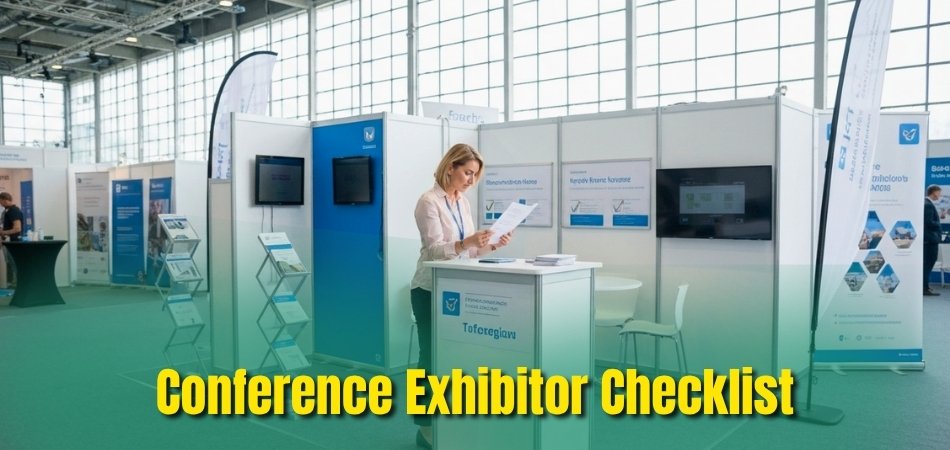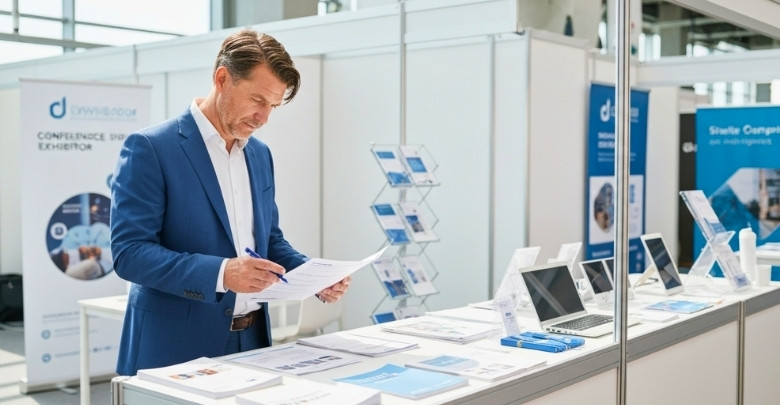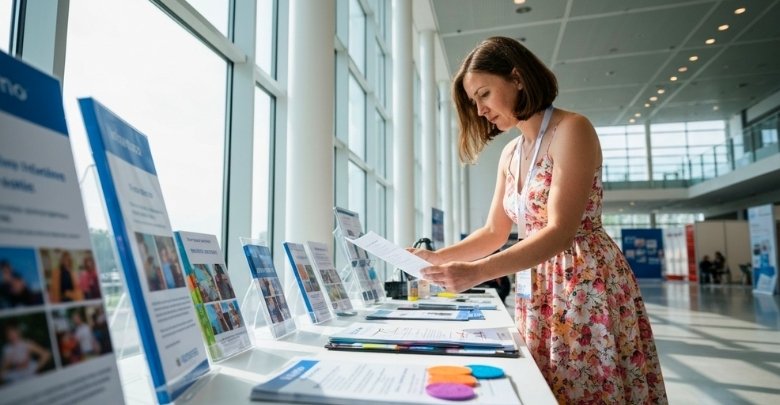Exhibitors often face a big challenge when preparing for events. There are so many things to think about, from booth setup to engaging with visitors. It’s easy to feel overwhelmed and worry about forgetting something important. That’s where a helpful tool like a conference exhibitor checklist becomes a real defining moment.
A conference exhibitor checklist includes goals and budget, logistics, marketing, booth setup, staff training, lead collection, daily booth management, and post-event follow-up. Reviewing performance and ROI ensures better planning next time. Staying organized from setup to follow-up helps maximize visibility, engagement, and results.
We understand you want to make your next event a huge success. You’re likely curious about how to avoid common pitfalls and ensure everything runs smoothly. Dive into this article to discover all the essential details you need for a winning exhibition strategy.
Conference Exhibitor Checklist
Having a conference exhibitor checklist helps make your event plan smoother. It guides you from setup to follow-up without missing important steps. With the right plan, you can save time, money, and stress. Below is a simple checklist to help you prepare for big events.
- Define Goals And Budget
- Logistics And Planning
- Marketing And Promotion
- Booth Materials And Setup
- Train And Prepare Staff
- Lead Generation And Engagement
- Daily Booth Management
- Post-Event Follow-Up
- Evaluate Performance And ROI
Define Goals and Budget
Start by setting clear goals for what you want to achieve. Make a budget that covers booth space, travel, and marketing. Keep spending within limits that match your company goals. This step gives your whole team a clear direction before the event starts.
Logistics and Planning
Read the event’s exhibitor guide carefully before you begin. Book your booth early and plan shipping for materials and displays. Work with official event partners for lighting, power, and setup help. Early planning prevents last-minute issues and helps everything run smoothly.
Marketing and Promotion
Spread the word about your company before the event begins. Update your website, social pages, and product info. Plan banners, ads, and giveaways to attract attention. This is important for big events like upcoming conferences in Canada, where standing out matters most.
Booth Materials and Setup
Prepare all booth materials ahead of time. This includes signs, samples, flyers, and business cards. Arrange your booth layout to look neat and inviting. Check that all materials arrive safely and match your brand style before the show starts.
Train and Prepare Staff
Make sure your team understands company goals and products. Train them to engage with people, answer questions, and gather leads. Having friendly and informed staff makes your booth more welcoming. Rotate shifts to keep everyone fresh and active throughout the day.
Lead Generation and Engagement
Collecting leads is one of the most important parts of exhibiting. Use forms, scanners, or apps to record visitor details. Engage people with short talks, demos, or contests. A simple smile and clear answers can turn curious visitors into new customers.
Daily Booth Management
Keep your booth tidy and stocked during the event. Secure valuables before leaving for the day. Review collected leads each evening to stay organized. A short daily meeting helps the team stay focused and ready for the next day.
Post-Event Follow-Up
Once the event ends, pack up carefully and ship materials back. Review the leads you collected and send thank-you messages. Share photos and updates from the event on your website or social media. This keeps your company fresh in people’s minds after the show.
Analyze Performance and ROI
Look back at what went well and what can be improved. Compare your actual spending with your planned budget. Measure how many leads turned into real results. This helps you plan smarter and get more value from future events.
A detailed exhibitor checklist saves time and money at every stage. It keeps your plans simple, clear, and easy to follow. With steady planning and teamwork, your booth can shine at any event. Stay ready and organized for your next big show.
Why Having a Conference Exhibitor Checklist Is Important?
Planning for a conference can feel like a lot of work. Many tasks need to be done well before the big day. A good checklist helps keep everything in order. It makes sure you do not forget anything important.
Stay Very Organized
A checklist is like a roadmap for your event. It lists every item and task you need. This keeps your team focused on what needs to be done. It helps you track progress clearly too. Being organized saves a lot of time later on.
Lessen Last-Minute Stress
When you use a checklist, tasks are done early. This means less rushing right before the conference starts. You can relax more knowing things are ready. It takes away the worry of forgotten details. A calm team works better.
Be Sure Everything Is Ready
This tool helps you check off every single item. From small supplies to big displays, nothing gets missed. It makes sure your booth is complete and ready. You will have all you need to make a good impression.
Manage Setup Smoothly
A clear conference exhibitor checklist helps teams stay organized, manage setup, and be better prepared when attendees approach exhibitors at a conference to learn more about their products or services. It means your booth looks great from the start. This makes your time at the event much easier.
Meet Your Conference Goals
With a checklist, you can focus on your main goals. You can talk to more people. You can share your message clearly. A well-prepared booth helps you reach your targets. This leads to a more successful conference for everyone.
Using a checklist really pays off. It makes your conference planning simple. It helps your team feel prepared and ready. This tool is a smart move for any exhibitor. Always have one ready for your next event.
Key Items to Include in Your Conference Exhibitor Checklist
Building a strong checklist means including key items. These items cover everything from big booth needs to small tools. Thinking ahead about these details helps you be ready. It ensures your booth runs smoothly on event day.
Booth Setup Supplies
This part of your list covers your physical space. Think about tables, chairs, and banners. Include power strips and extension cords. Do not forget tape, scissors, and zip ties. These items make your booth look neat and work well.
Marketing Materials
You will need plenty of handouts or brochures. Bring business cards for your team. Prepare a sign-up sheet for emails. Have small gifts or swag items ready. These materials help share your company’s story clearly.
Technical Equipment
List any laptops, tablets, or monitors you need. Remember chargers for all devices. Check that your Wi-Fi hotspot works. Bring any needed adapters or cables. Test all tech before you leave for the event.
Staff Needs and Comfort
Make sure your team has comfortable shoes. Pack water bottles and snacks for energy. Bring hand sanitizer and first-aid items. Have a schedule for breaks ready. Happy staff make for a better booth experience.
Logistics and Paperwork
Include copies of your booth rental agreement. Have shipping labels and tracking info ready. Bring emergency contact numbers for staff. Keep a list of important event contacts. This helps if any issues come up.
Putting these items on your list helps you remember everything. It covers all the important parts of your setup. A complete list means you are ready for anything. It helps make your conference time successful.
Common Mistakes Exhibitors Make When Preparing for a Conference
Even with a checklist, mistakes can happen. Some errors are very common for exhibitors. Knowing these ahead of time can help you avoid them. Being aware makes your preparation much stronger. It helps you have a smooth event.
Forgetting Small, Key Items
Often, big things get remembered, but small ones are forgotten. Think about pens, sticky notes, or a stapler. These small tools are very useful. Forgetting them can cause a few delays. Always check for tiny but important items.
Skipping Setup Checks
Many teams pack items but do not check them. Test your laptop, printer, or demo unit at home. Make sure everything turns on and works well. This prevents bad surprises at the conference. A quick test saves big trouble.
Not Having Backup Equipment
One common mistake is not recognizing the difference between attendee and exhibitor — exhibitors must prepare marketing materials, display setups, and lead forms, while attendees only need session schedules or notes. Always pack backup chargers or a spare laptop. Having a plan B is very wise.
Underestimating Time Needed
Setting up a booth takes longer than you think. Do not plan to arrive an hour before doors open. Give yourself plenty of time to set up. Factor in traffic or unexpected issues. Rushing causes mistakes and stress.
Poor Staff Briefing
Your team needs to know their roles. They should understand what to say to visitors. Make sure everyone knows the goals of the event. A well-briefed team works well together. This makes your booth more effective.
Learning from these common errors is smart. It helps you prepare with more care. Use your checklist to cover these weak spots. This way, your team will be ready for anything. You will have a much better conference event.
Tips for First-Time Exhibitors Using a Checklist
If this is your first time, a checklist is your best friend. It helps you feel ready and sure. These tips will help you use your list well. They make preparing for your conference much easier.
- Start Early: Begin your planning weeks before the event. This gives you plenty of time to get everything ready.
- Break It Down: Divide your big checklist into smaller parts. Focus on one part at a time to avoid feeling lost.
- Assign Roles: Give different parts of the checklist to team members. Everyone knows what they need to do.
- Use Clear Notes: Write down details for each item. For example, “Booth banner: pick up from printer.”
- Review Often: Look over your checklist every few days. This helps you track progress and catch anything missed.
- Do a Dry Run: If possible, set up parts of your booth before the event. This helps you see what works.
- Pack a “Go Bag”: Keep small, important items in one bag. Things like pens, chargers, and snacks go here.
- Ask for Help: If you are not sure, ask someone who has exhibited before. They can offer good advice.
These tips help new exhibitors use their checklists well. They make the whole process smoother. You will feel more ready and sure of your steps. A good start means a good conference event.
Frequently Asked Questions
It’s normal to have more questions when preparing for a big event like a conference. We’ve gathered some common questions that exhibitors often ask, especially when getting ready for their booth. Hopefully, these answers will help clear up any remaining doubts you might have and make your planning even smoother.
What Is the Best Way to Follow Up With Leads After a Conference?
Following up quickly is super important. Try to send a personalized email within 24-48 hours after the event, reminding them of your chat. You can also connect on professional networking sites like LinkedIn to keep the conversation going. Make sure your message offers real value, like a helpful resource or a solution to a problem they mentioned.
How Can I Make My Booth More Engaging For Visitors?
To make your booth stand out, think about interactive elements. You could have a live demo, a small game, or a poll that visitors can take part in. Offer clear, easy-to-understand information about what you do, and have friendly staff ready to chat. A comfortable seating area or free Wi-Fi can also attract more people.
What Are Some Effective Ways to Attract More People to My Stand?
Beyond having a great setup, consider pre-event promotion. Use social media to tell people you’ll be there and what they can expect. During the event, consider a small contest or a prize drawing to create buzz. Also, make sure your signage is clear and inviting, letting people know what problem you solve.
Should I Offer Giveaways or Promotional Items at My Booth?
Yes, giveaways can be a great way to attract visitors and leave a lasting impression. Choose items that are useful, relevant to your brand, and have your logo clearly visible. Think beyond simple pens; perhaps a small tech accessory or an eco-friendly item. Remember, the goal is to remind people of your brand long after the conference.
How Do I Train My Staff for Interacting With Attendees?
Training your team is vital for a good impression. Make sure everyone knows your key messages, how to answer common questions, and how to use any demos. Practice active listening and learn how to smoothly transition conversations towards collecting lead information. Also, emphasize the importance of being approachable and friendly to everyone.
What Is the Ideal Booth Location for Maximum Visibility?
While you might not always pick your spot, aim for high-traffic areas if possible. Corners, spots near food or restrooms, or close to popular session rooms are usually good. Try to avoid being tucked away in a corner or directly opposite a major competitor. A visible location helps more people see your booth naturally.
How Can I Measure the Success of My Participation?
Measuring success goes beyond just collecting business cards. Set clear goals beforehand, like the number of leads, new connections, or product demo sign-ups. Track these metrics during and after the event. You can also send out a post-conference survey to gather feedback from your team about the experience.
What Kind of Display Graphics Work Best for a Booth?
Effective display graphics are clear, concise, and visually appealing. Use large fonts that are easy to read from a distance and high-quality images. Keep your main message simple and impactful, so people can understand what you offer at a glance. Your branding should be consistent and professional to build trust.
Are There Any Special Considerations for International Conferences?
For international events, language and cultural differences are key. You might need staff who speak multiple languages or have multilingual marketing materials. Research local customs regarding business interactions and gift-giving. Also, be aware of different power outlets and shipping regulations for your equipment.
How Far in Advance Should I Start Planning for an Event?
Starting early is always best, ideally three to six months before the conference. This gives you plenty of time to book your booth space, design marketing materials, and coordinate logistics. Early planning also allows you to secure better rates and ensures you don’t miss any deadlines. It helps avoid last-minute rush and keeps stress low.
Conclusion
Getting ready for a conference doesn’t have to be stressful. By using a good plan, you can make sure everything is perfect and runs smoothly. This is why having a thorough and reliable conference exhibitor checklist is absolutely key to your success.
Remember to start early, stay organized, and always have backups. With careful planning and attention to detail, you will surely shine at your next event. We wish you the very best for a successful and memorable conference!








